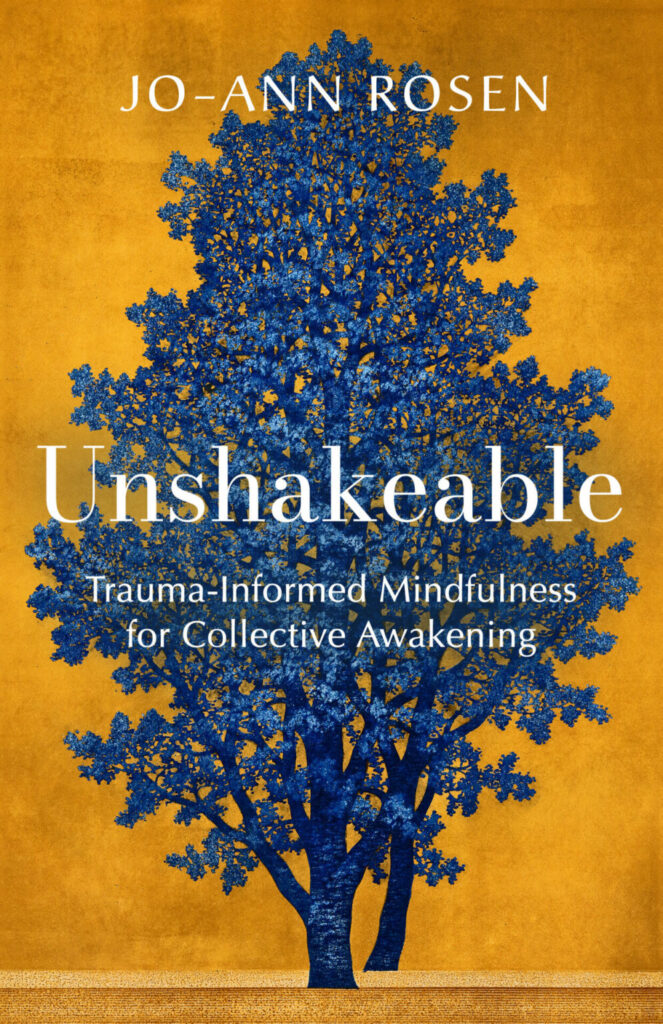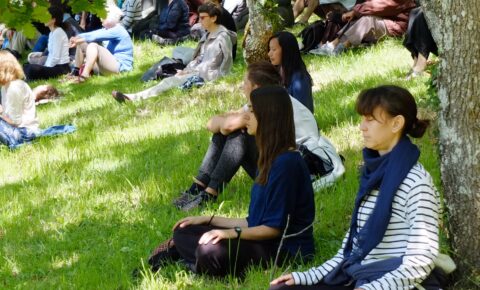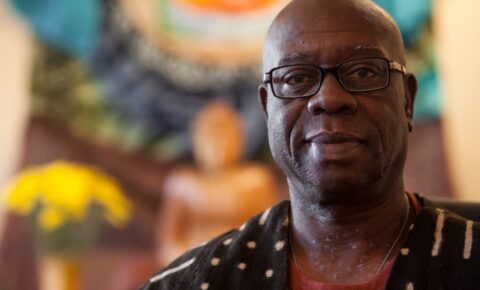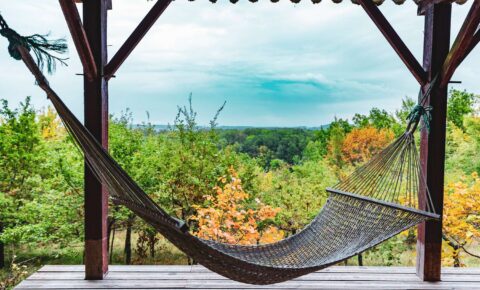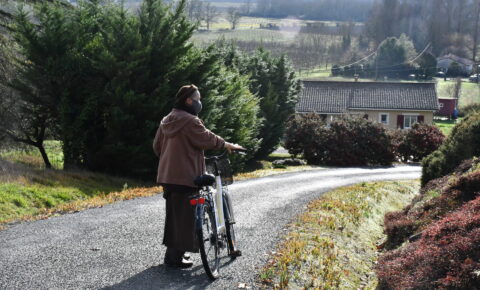Dharma Teacher Jo-Ann Rosen offers practices for wise activism in alignment with the Engaged Buddhist path.
Mindful of a dysregulated nervous system
I hope that what we can do together today is to have one small takeaway that might inspire you to be yourself, to slip into fearlessness and to be able to really embody the calling that is authentic for you. To put the contents of my book into this workshop and give you the experience of it started to dis-regulate me big time this week. I already have felt dysregulated with the unrelenting heat here that hit 117 for a while, with the things that are happening in Israel, Gaza and the West Bank – a place I’ve been working, and where I have a lot of people that I care deeply about. With the upcoming election, it’s been compounded.
I’m noticing that I started to have trouble sitting. I could not sit still. Inside it felt like I needed to be yelling or running or breaking things. So that should have been a clue for me to start taking better care of myself and it wasn’t. It wasn’t enough of a clue so yesterday when I was preparing for this and trying to figure out how to pair down what I was going to say, my car died. I was trying to problem solve that and prepare for a wedding coming up at our house and I could feel my body just getting more and more tense. Then I didn’t sleep hardly at all last night so this morning I thought – I was going to talk about my activism in the West Bank – I could have talked about working with trauma victims in Chiapas – but really I need to talk about what I did to help myself today. The two exercises that we’re going to do together – I didn’t have the ability to do myself.
Today I had to stick to very simple mindfulness practices, watching my steps, feeling the texture under my feet, going outside and feeling the sun scorching my skin, and drinking a whole bunch of water. Those were the kinds of very simple regulating systems for this body, because I haven’t been able to adapt to unrelenting stress and I think neither have you.
The stresses are piling up and in fact we don’t have a nervous system that deals with unrelenting stress. Our nervous system is really evolved to be hunter gatherers. It takes tens of thousands of years for our nervous system to even do a little adapting. So what we’re doing is we’re walking around with a nervous system that’s meant for a hunter gatherer lifestyle and that’s a mismatch with what we live in. Our challenge is to figure out how we can regulate our nervous system, because when our nervous system is dysregulated we’re on automatic – we’re in threat mode even though the threat may not be life threatening – it feels life threatening.
A red light at the wrong moment when you’re late for something can feel life threatening. Our bodies are responding as if we’re in danger and when we’re in danger the brilliant evolution of our nervous system is that we go really fast, either to fight or to run away and you can feel that fight or that runway in your body as your arms and your legs get more charged, as your heart goes fast, as your breathing goes fast.
Harmonising body and mind
Where we put our attention becomes our reality so if we learn how to put our attention to the wholesome safe islands all around us, which are always there, we can actually calm our body and fool our nervous system into thinking everything is fine. Then our body calms down and we’re no longer in a fight or flight mode and when that happens the cognitive, the receptive, the creative, problem solving and interpersonal social self can come online.
Here’s a very interesting look at a mudra in Buddhism of wisdom, of making a fist with a finger pointing up and then embracing that finger. This is wisdom and to me this is being able to soothe our body so that the threat mode only has a little bit showing. We don’t want to get away completely from the part of us that’s watching for threat, but we want to embrace it like a baby and then our cognitive part comes online and this is our wisdom.
Our wisdom is an optimal balance between being vigilant – but not too much – so that the cognitive part of us can actually run the show, and when we learn to do that we can make decisions that are based on wisdom.
Activism as a vehicle for awakening
This is called ‘‘activism as a vehicle for awakening’’ and I’m guessing that many of you came to this today because you have a concern for the state of our earth, for the state of our human civilization and even though you may be coming for many different reasons, there’s a calling inside of you that wants to help heal the world. That has certainly been a strong call for me in my life. But it also hasn’t always been an intelligent way for me to show up.
When I was in my early 30’s I got smitten with the idea of going to stop nuclear power plants and go to get an arrested. I have to say that there was a part of me that was truly worried about nuclear, nuclear everything but there was also a part of me that found it romantic to join with a bunch of people and get arrested and go to jail and do the things that we did back in those days. It seemed like we were being very effective but what I noticed during those days was that there was a lot of ego showing up in the variety of leaders. I wouldn’t call everything that happened during those days skillful. I might not want to participate in those anymore even though the thing that drew me, still stands alive in me today.
What I notice is that when we’re all riled up, this (prefrontal cortex) is not in charge. We’re not using our wisdom to create wise action and why is that? It is because we’re so unaccustomed to regulating our nervous systems that we’re easily manipulated by chaos, by other people yelling or things going too fast. Going into meetings where someone’s taking over and we don’t know how to stop it and we get nervous. So the very first thing we need to do when we want to be activists is to know that the kind of action that we’re doing comes from a wise broad view.
When human beings first roamed the earth we were these hunter gatherers and the hunters were very clever. They were able to hunt so much, almost to extinction, that their food supply began to dwindle and they were forced to figure out how to make the plants more productive because the animals were becoming very scarce.
Big picture thinking and interbeing
While we were clever as human beings, we were clever in the short run and we didn’t have a big picture of what we were doing. I think that that applies to many of the things that human beings have done so that our shortsightedness which helps us survive, because we can mobilize to danger very quickly, also clouds our ability to see a big picture. Because when we’re dysregulated, when we’re very highly activated we’re focused very much on whatever it is that dysregulates us and we don’t see the big picture and that’s been true throughout history. That human beings act quickly. We’re shortsighted and the intention of our actions boomerangs because we don’t see the long-term impact.
So how do we do that as activists? How do we see a big picture? How do we see the interbeing nature of what we’re doing? We must have this cognitive perspective rather than being all riled up and how do we do that? We need to know when we’re actually dysregulated and we can feel that in our bodies. But our lifestyle is so much out there in the world that we’re not really in touch with our bodies and the subtle and not so subtle signals that tell us – hold on a minute, you need to bring yourself down – because actually the cognitive part must be online in order to be mindful, in order to be curious, in order to see things as they are. So the first step towards mindfulness and having a big picture is to regulate ourselves.
Right effort meditation
Get yourself comfortable. We’re going for the optimal balance between alertness and relaxation. You might even try going like this (wisdom mudra) and see if that feels pleasant, unpleasant or neutral. Notice how your body is feeling on the inside like a pre-test. There’s no right or wrong, we’re just going to spend time noticing and if anything that we do together doesn’t feel right to you, know that you are in choice. Being in choice in and of itself can help regulate your nervous system. If you need to be lying down, lie down, if you need to be standing and moving around – do it. If you need to be sitting still or rocking, try it out. You might want to look around and make sure that your surroundings are good enough so if you feel like closing your eyes you’ll feel safe.
We’re going for a sense of well-being or good enoughness. Good enough not to be on high alert. You can say hello to your body. You might not have said hello yet today. You might enjoy taking a deep breath if you feel a little drowsy. You might hold the breath in, big breath in, and if you feel like you need to regulate down you might want to just focus your attention on a long slow out breath.
Notice the impact on your body of the breath. There’s no right way, we’re just noticing and if we had enough time we could notice for a long time, our toes, our feet, the temperature, the clothes against our skin, the tension in our muscles. We’re going to date our body right now with just scanning your body on the hunt for some part of the body that feels good enough, relaxed enough or maybe even pleasant. It might just be a slight breeze going across your cheek or it might be that your knee doesn’t hurt quite as much as it did this morning.
See if you notice anything inside where you can rest your attention at ease. When your mind wanders – because that’s the nature of the mind – it’s always on the alert for safety – just bring it back to the curiosity of – is there anywhere in there that’s good enough right now? Maybe it’s the sensation of weight, solidness where your bottom is being supported. Maybe it’s the sensation of your feet or your knees or your hands weight. This can feel really good. Maybe you can feel your heartbeat in various parts of your body. You may feel it in your throat or your chest, even your arms or your fingers. Just notice how this process of noticing our bodies is affecting how we feel inside. Then knowing that you could really spend a nice half hour or 45 minutes doing this. If you feel like venturing into a different kind of well-being, bring to mind something that is almost always guaranteed to feel good. It might be the image of a dear one or a place that you enjoy. It might be an animal companion or a piece of music.
Well-being comes in so many different shapes and sizes. Bring to mind just one thing that has the quality of well-being without any bitter sweetness and bring it to mind in detail. What you see in your mind’s eye or perhaps what you’re doing. What sounds might be there, what thoughts go with it? Ask yourself what are the very best parts of this? What makes this sing for me? As you make an attempt to reinhabit that memory, notice how that impacts the body. Is there anywhere in the body where you feel that sense of well-being even just a little bit? Just one breath worth. If you’re noticing something pleasant or even neutral or relaxing or good enough arising inside from this sense of remembering, you might consider putting a hand on that part that is responding to your images, to hold your attention there as you are watering the seeds of well-being.
You are greasing and strengthening the neural pathway to this particular flavor of well-being. The longer and more frequently you visit this very place inside, the easier it will be to access this sense of well-being to help regulate your nervous system. Maybe as you do this you notice a word or a body movement or a gesture that feels like it encapsulates it. Maybe it’s just one little image that helps you remember it and perhaps taking a deep breath in and knowing that remembering this can remind you to revisit it at another time. Just as you have savored this experience, so too can you create a lifestyle where you are watching for these moments.
Slowing down enough to savor them right when they’re happening and knowing that you can continue savoring them, even when that time has passed. These are watering wholesome seeds. This is foundational to our practice. Right effort waters wholesome seeds and calls them up at will to water them some more. Taking perhaps one or two more breaths and allowing the sound of the bell to accompany a sense of well-being – we gently end this meditation.
Jo-Ann goes on to share the second practice for cultivating right effort.
This workshop is part of a series offered by Deer Park on Engaged Buddhism.
You can purchase Jo-Ann’s book ”Unshakable” from the Parallax Press Website.
